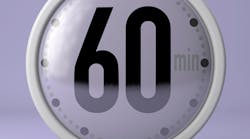Why 60 minutes works: Here's the case for one-hour block scheduling for dental appointments
By Karen Davis, RDH, BSDH
What's ideal for a dental hygiene appointment? 40 minutes? 60 minutes? Customized? If you spend much time at all visiting dental practices, you quickly learn there is no "template" followed consistently for dental hygiene appointments.
Dental hygienists may work two days a week in a practice that schedules one adult patient every hour, two days a week in another practice that schedules prophy patients every 30 minutes with an assistant to overlap the appointments, and one day a week in a practice that schedules a fluctuation of 30-, 40-, 50-, and 60-minute appointments, depending on the services being provided.
Is there a correct time allotment for practices to schedule hygiene patients? How can you schedule productively and comprehensively at the same time? While there is no perfect formula for every situation, for adult patients and permanent dentitions I'm a big advocate of one-hour block appointments.
I invite you to consider the value of one-hour block scheduling for today's dental hygiene visits for the following reasons:
1. When a prophylaxis patient cancels at the last minute, the scheduler can easily place a periodontal maintenance patient into that appointment time. When all adult appointments are one-hour blocks, this gives the hygiene coordinator the freedom to make calls to the list of people waiting to get into the first available appointment. When appointment times vary, it limits what type of an appointment can be filled at the last minute. What also often happens is that patients who need 60 minutes are squeezed into 40-minute appointments, and the hygienist is just supposed to figure it out. Sadly, this generally means important screenings, education, or services are left out due to time constraints. When all adult appointments are one hour, the patient and clinician do not feel rushed.
2. One-hour block appointments enable clinicians to realistically customize priorities for each patient's needs. As dental hygienists, we see everything. Some patients describe hot, cold, and biting pressure somewhere in their mouth, but they can't identify where. Some patients present with significant bleeding upon probing that wasn't documented previously. Patients bring laundry lists of new medications with them, and updated diagnoses of conditions that have significant oral implications. They present with pending treatments that were diagnosed months ago, but because nothing is hurting they never scheduled and can't recall the reasons for the diagnosis. Patients want to discuss whitening their teeth, their TMJ discomfort, and the pros and cons of traditional ortho versus Invisalign. They ask us whether veneers are really worth the cost and why implants are so expensive. They tell us about their concerns related to a previous visit that didn't meet their expectations. The list could go on on, and dental hygienists can relate. Scheduling only the time required to clean someone's teeth does not leave a margin for managing the real-life priorities that emerge after the patient has been seated.
3. One-hour block appointments afford dental hygienists the opportunity to work in concert with the dentist for confirmation of diagnosis and treatment enrollment. When dental hygienists have adequate time to provide thorough periodontal screenings, restorative, occlusal, and esthetic screenings, oral cancer screenings, caries assessments, and necessary education related to their findings prior to the dentist's exam, it conveys a strong message of continuity. If the doctor exam doesn't occur during the allotted time of the dental hygiene appointment, and happens after the dental hygienist has moved on to another patient, this is a missed opportunity for the patient to hear the dental hygienist's synopsis of findings delivered by the dentist. I have found that when the dentist asks for a synopsis of findings, the dental hygienist provides a recap of findings, and the dentist confirms the diagnosis all within the appointment, this creates a "triangle of communication" that builds trust and increases case acceptance.
Perhaps the 40- or 50-minute adult dental hygiene appointment was realistic when we believed calculus was the culprit and its removal was the primary focus of visiting the dental hygienist. Consideration of the close association between oral health and systemic health coupled with new technologies warrants a new look at the time allotment issue.
If you are not currently providing comprehensive services within a one-hour appointment block, perhaps it's a good time to have a conversation with your employer to talk about how much more productive and effective you could be in that amount of time. I've not met many dental hygienists who feel one-hour block appointments are too much time for the multitude of services and education that can be provided, but I've met many who are frustrated with the growing list of expectations in the dental hygiene appointment without adequate time to support them.
There is a myth in dentistry that dental hygienists must physically see more patients to be more productive. I have found just the opposite to be true in the majority of cases. Adequate time per patient creates opportunities to be more comprehensive and more productive. It's a win/win! RDH
Karen Davis, RDH, BSDH, is the founder of Cutting Edge Concepts, an international continuing education company, and practices dental hygiene in Dallas, Texas. She is an independent consultant to the Philips Corp., Periosciences, and Hu-Friedy/EMS. She can be reached at [email protected].







